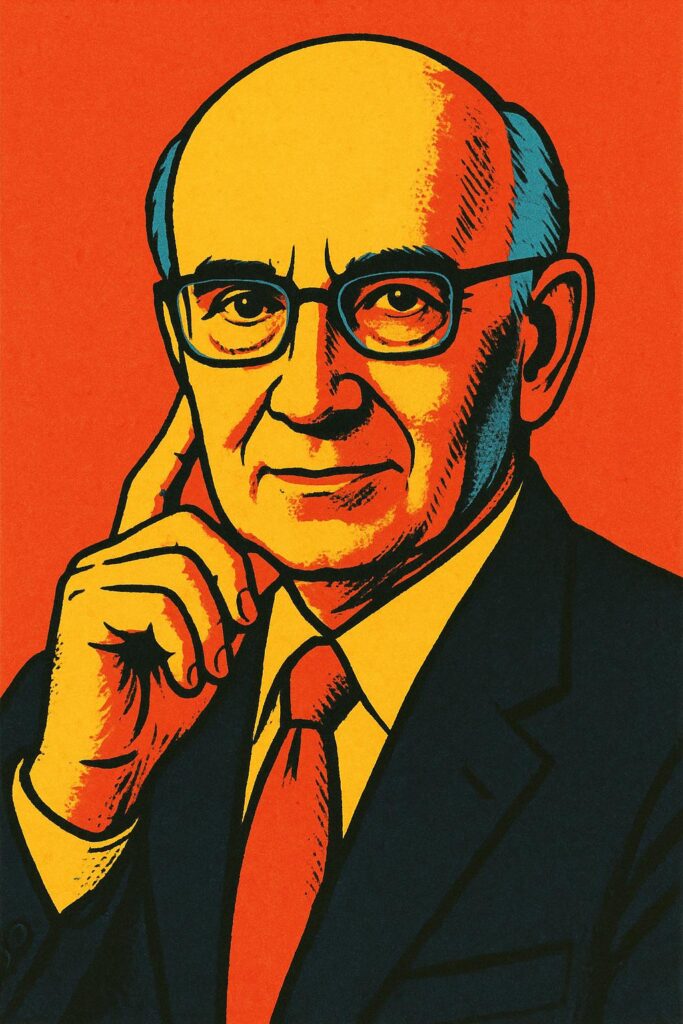Philip Kotler’s work turned marketing into a systematic science. Kotler’s mix of economics, behavioral psychology, and strategic thinking changed how professionals and academics view the field.
His models help businesses understand needs, create value, and build meaningful relationships with customers. These blueprints, like the famous 4Ps and STP model, are now standard practice in classrooms and boardrooms around the world.
Kotler’s academic groundwork, frameworks and insights continue to influence how organizations connect with people, drive progress, and solve modern business challenges. His ideas moved beyond textbooks. They became standard features of global companies, nonprofits, and digital platforms, and made him a cornerstone of marketing as we know it today.
Academic Roots and Economic Curiosity
Kotler’s early fascination with economics began during his studies at the University of Chicago, where the influence of economists like Milton Friedman shaped his analytical mindset.
He initially set out to explore economics but soon realized that understanding markets demanded more than mathematical models and theories.
His curiosity led him to probe the human side of buying and selling. He leaned on behavioral psychology to bridge the gap between theory and practice.
Kotler’s academic journey included a doctorate at MIT, where he questioned traditional approaches and immersed into marketing’s potential for solving real business problems.
Instead of limiting himself to economic formulas, he examined what drives customer decisions, how companies identify new needs, and the forces shaping the marketplace.
This shift sparked his lifelong effort to anchor marketing as a scientific discipline.
Building the Marketing Discipline
The 4Ps
Kotler’s contribution to the field began with his introduction of the 4Ps: Product, Price, Place, and Promotion. This model gave businesses a practical way to organize their marketing efforts and make effective decisions.
The 4Ps framework helps clarify four essential questions:
- Product: What goods or services are offered, and how do they meet customer needs?
- Price: How should these offerings be priced to reflect value and remain competitive?
- Place: Where and how will the product be distributed, and be accessible to the right customers?
- Promotion: What methods and channels will be used to communicate the product’s value and persuade customers to buy?
 Segmentation, Targeting, Positioning
Segmentation, Targeting, Positioning
Rather than taking a one-size-fits-all approach, Kotler advocated dividing the market into subgroups based on shared characteristics such as age, income, lifestyle, or buying behavior. Companies could identify which segments are most profitable or underserved, and then develop messaging, products, and services that specifically address each segment’s expectations and pain points.
He then refined these ideas into the STP model: Segmentation, Targeting, Positioning.
- Segmentation involves dividing the broad market into distinct groups;
- Targeting is the process of selecting which of these groups to serve
- Positioning means crafting the brand’s image and messaging to best appeal to the chosen segment.
According to Kotler, real marketing success comes from matching company strengths to the right group of people, not from trying to serve everyone equally. This way, businesses create more value for both customers and the company itself.
Value Creation and Delivery
Kotler’s concept of value creation and delivery marked a shift in marketing, moving the focus away from simply pushing products to building meaningful, long-term relationships with customers. He argued that successful marketing goes beyond transactions and emphasizes the importance of consistently delivering value to the customer.
In Kotler’s opinion, value is created by understanding customer needs deeply, designing products and services that truly address those needs, and then delivering them in a way that exceeds expectations. This approach makes customers more likely to return and recommend the brand to others.
From Theory to Boardroom
Kotler’s theories moved quickly out of academic circles and into practical business use.
His textbook, “Marketing Management,” became essential reading for both MBA students and corporate leaders.
Companies started using Kotler’s frameworks as checklists for launching new products, setting prices, and defining market strategies.
Consulting projects took Kotler’s expertise global. He helped businesses in North America, Europe, and Asia refine their marketing campaigns, optimize product launches, and improve customer retention.
His ideas also shaped how nonprofits and public agencies communicate their mission and attract funding.
The table below summarizes some areas of real-world application:
| Area | Kotler Principle Applied |
|---|---|
| Product Launch | 4Ps, STP Model |
| Customer Loyalty | Value Creation, STP |
| Global Expansion | Segmentation, Positioning |
| Nonprofit Outreach | Communication Strategy |
Why Kotler Still Defines Modern Marketing
Kotler’s models remain the bedrock of marketing education and practice since they adapt to new challenges and environments.
For example, the 4Ps and STP are taught in classrooms and demanded by employers because they help clarify decision-making across industries.
As businesses moved into the digital age, these principles proved flexible enough to support everything from ecommerce launches to social media campaigns.
In the nonprofit sector, his emphasis on value and structured communication guides how organizations reach supporters.
Tech companies and startups also rely on segmentation and positioning as they navigate competitive marketplaces.
Even in government and healthcare, institutions use his principles for effective service delivery and public campaigns.
| Sector | Application Example |
|---|---|
| Digital Retail | Content and UX strategy |
| Nonprofits | Donor engagement plans |
| SaaS | Niche audience targeting |
| Healthcare | Patient communication |
The Professor with Global Impact
Philip Kotler’s influence reaches far beyond academic halls and corporate offices. He has delivered lectures and keynotes on every continent.
He has received numerous honorary degrees from universities in countries such as Sweden, India, and Italy. This reflects the widespread appreciation for his work. His books have been translated into over 25 languages, making his ideas accessible to students and professionals worldwide.
A frequent traveler, Kotler enjoys exploring global trends firsthand, sometimes joining local marketing events as a guest of honor. He is known for his down-to-earth teaching style, using humor and storytelling to make concepts stick.
Kotler has served as an advisor to nations on public policy and tourism. His projects have included branding entire cities or regions, demonstrating his creative impact in unexpected contexts.
He is passionate about jazz music and art, often fitting cultural events into his travel itineraries.
Awards such as the American Marketing Association’s “Leader in Marketing Thought” cement his legacy as a mentor and innovator in the field, while his approachable style and varied interests make him a memorable figure in marketing history.
Summary
- Philip Kotler transformed marketing into a rigorous, people-focused science.
- He developed the 4Ps and STP models, giving marketers clear frameworks and shared vocabulary.
- Kotler’s principles help organizations make smarter decisions, clarify goals, and build trust.
- His work prioritizes solving business challenges through customer understanding and value creation.
- He encouraged leaders to ground decisions in research and strategy, not just intuition.
- Kotler’s models are applied widely, from product design to digital content and nonprofit outreach.
- Universities around the world use his ideas to train future leaders and marketers.
- His global teaching and consulting led to innovative marketing across new regions and industries.



